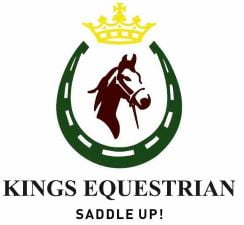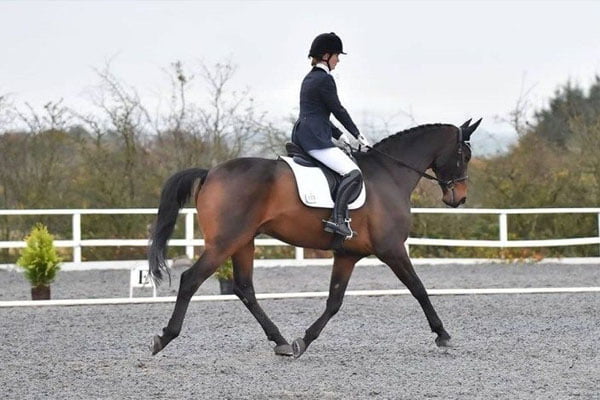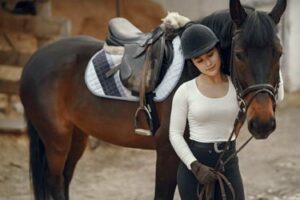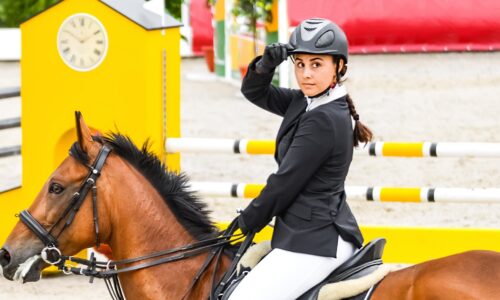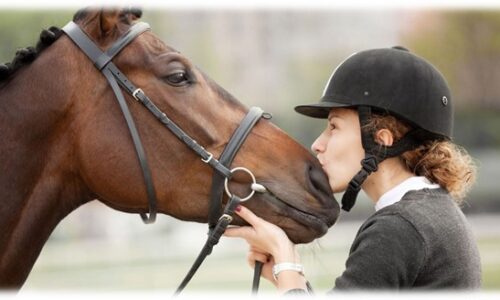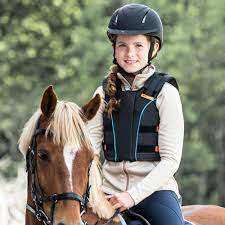Equestrian Rider: Level 1
Riders at Level 1 are in the beginning stages of their equestrian development. At this stage the riders are well started in the basics of riding and are able to demonstrate a good position, knowledge of “aids” and an appreciation for “safe” habits. Riders can post/rise to the trot but are not yet aware of diagonals. They can change diagonals when asked.
Riders at this level should not be balancing on the horse’s mouth. Hands should be independent at walk. The use of a neck strap in the absence of a standing martingale neck strap is allowed periodically at the trot. Contact is applied to stop, turn and slow down. Reins are then returned to an inactive state.
At this level riders must wear an ASTM approved helmet that is properly fitted, hard soled, heeled, ankle boots
or higher and fitted, seamless pants. Half chaps are permissible. A well-fitted shirt with a collar and tucked into the pants or breeches is recommended with a belt that is visible. Gloves are recommended at all levels. Hair must be either tucked into the helmet or kept tidy with a hair net. A single braid is acceptable if hair is very long.
Tack should be used as it is normally for the rider/horse combination. Running and standing martingales are acceptable as are boots etc. so long as they are clean and properly fitted.
The horse need not be braided or clipped, but an effort should be made to make a good presentation. All equipment must be clean and neat.
The test is to be conducted in a ride format. The test organizer will appoint a person, (possibly the regular instructor), to give the directions and control the safety of the group during the testing.
Safety, and a willingness to learn about the horse/pony is emphasized at this level.
Rider 1 – Stable Management Requirements
The candidates should demonstrate an awareness of the basic parts of the horse and of their equipment, and that they can, with assistance, be involved in the daily care of their horse.
Turnout should be neat and workman like. Paddock boots, work boots, or riding boots and neat sweat pants or slush pants over breeches are acceptable. Loose, baggy jeans or shirts are not acceptable.. Hair should be tied back. Ball caps that cover the eyes are discouraged.
Riders will be expected to:
- Rinse the bit to rid it of any dirt that may harden and become uncomfortable for the horse the next time it is used
- Put the bridle up in a figure of eight arrangements
- Enter the stall, approach the horse/pony safely and put the halter on
- Lead the pony or horse out of the stall properly, turn it correctly, take the horse/pony back into the stall and remove the A lead line or chain should be attached correctly
- Know the color of the horse they are using for the test
- Know which side is the “near” side and which is the “far” or “off ” side
- Demonstrate how to feed a treat and what types of foods are best to offer as treats. (Rules for feeding treats may differ from one stable to another).
- Attempt to tack up. If an evaluator assists, the student/candidate must direct the process
Rider 1 – Riding Requirements
Riders will be required to:
- Adjust stirrups from the ground; tighten the girth; put reins over the horse’s head
- Mount in the correct, safe manner (from ground or block)
- Dismount and lead the horse in hand
- Adjust the girth and stirrups (assistance allowed)
- Pick up reins correctly while mounted
- Demonstrate the correct position at walk
- Identify the direction of travel (ie left rein, right rein)
- Demonstrate the correct position at trot (rising)
- Drop and retake stirrups at walk
- Demonstrate change of rising/posting diagonal when asked
- Demonstrate transitions at walk/trot
- Ride the centerline at walk
- Ride across the school at walk E to B or B to E
- Change rein on long diagonal at trot
- Halt from walk
- Identify and maintain a safe distance in a group ride
- Demonstrate overall authority, safety and confidence
Course Features
- Lectures 26
- Quizzes 17
- Duration Lifetime access
- Skill level All levels
- Language English
- Students 89
- Certificate Yes
- Assessments Yes
